Information Systems & IT Solution: Theories, Methods, and Techniques for Design and Development
VerifiedAdded on 2023/06/14
|11
|3242
|75
AI Summary
This report discusses the theories, methods, and techniques for designing and developing IT solutions like McAfee, Moodle, Canvas, and MS Office. It also explores the impact of IT on globalization and the risks associated with information systems outsourcing. Additionally, it covers the definition, advantages, and disadvantages of digital infrastructure. The report is relevant to the subject of Information Systems & IT Solution, course code BMP4005, for BSc (Hons) Business Management, Cohort 2, at an unspecified college or university.
Contribute Materials
Your contribution can guide someone’s learning journey. Share your
documents today.
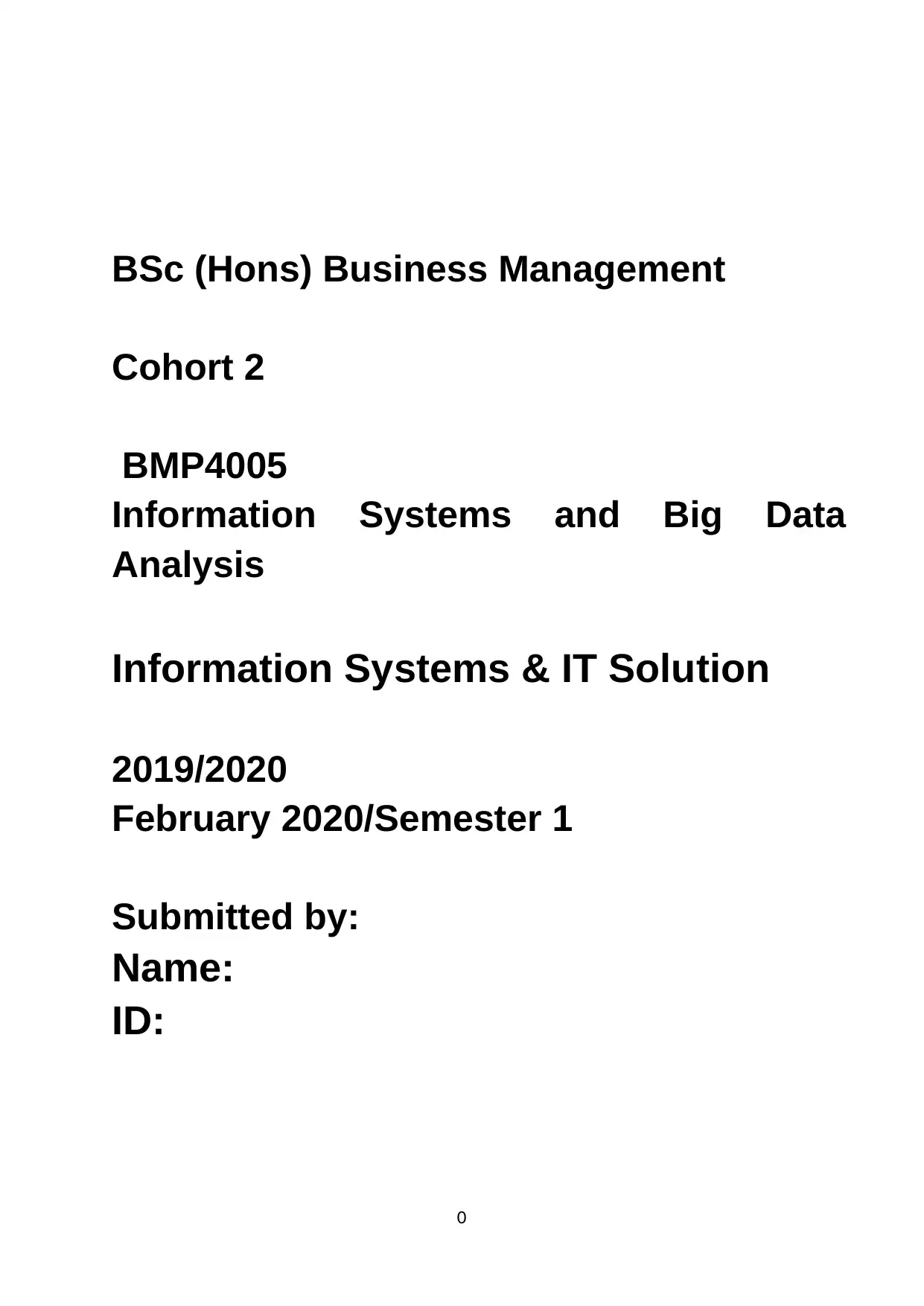
BSc (Hons) Business Management
Cohort 2
BMP4005
Information Systems and Big Data
Analysis
Information Systems & IT Solution
2019/2020
February 2020/Semester 1
Submitted by:
Name:
ID:
0
Cohort 2
BMP4005
Information Systems and Big Data
Analysis
Information Systems & IT Solution
2019/2020
February 2020/Semester 1
Submitted by:
Name:
ID:
0
Secure Best Marks with AI Grader
Need help grading? Try our AI Grader for instant feedback on your assignments.
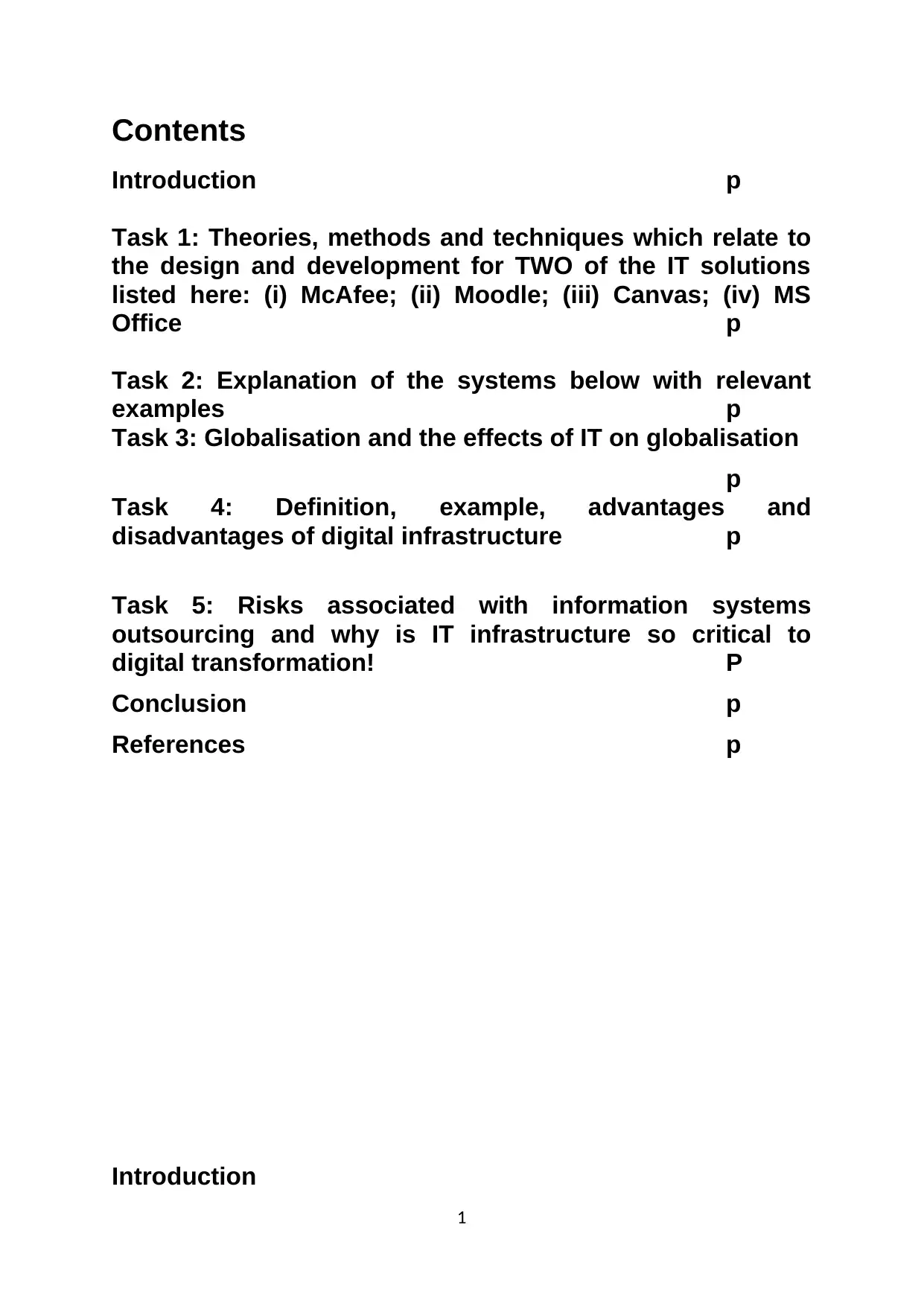
Contents
Introduction p
Task 1: Theories, methods and techniques which relate to
the design and development for TWO of the IT solutions
listed here: (i) McAfee; (ii) Moodle; (iii) Canvas; (iv) MS
Office p
Task 2: Explanation of the systems below with relevant
examples p
Task 3: Globalisation and the effects of IT on globalisation
p
Task 4: Definition, example, advantages and
disadvantages of digital infrastructure p
Task 5: Risks associated with information systems
outsourcing and why is IT infrastructure so critical to
digital transformation! P
Conclusion p
References p
Introduction
1
Introduction p
Task 1: Theories, methods and techniques which relate to
the design and development for TWO of the IT solutions
listed here: (i) McAfee; (ii) Moodle; (iii) Canvas; (iv) MS
Office p
Task 2: Explanation of the systems below with relevant
examples p
Task 3: Globalisation and the effects of IT on globalisation
p
Task 4: Definition, example, advantages and
disadvantages of digital infrastructure p
Task 5: Risks associated with information systems
outsourcing and why is IT infrastructure so critical to
digital transformation! P
Conclusion p
References p
Introduction
1
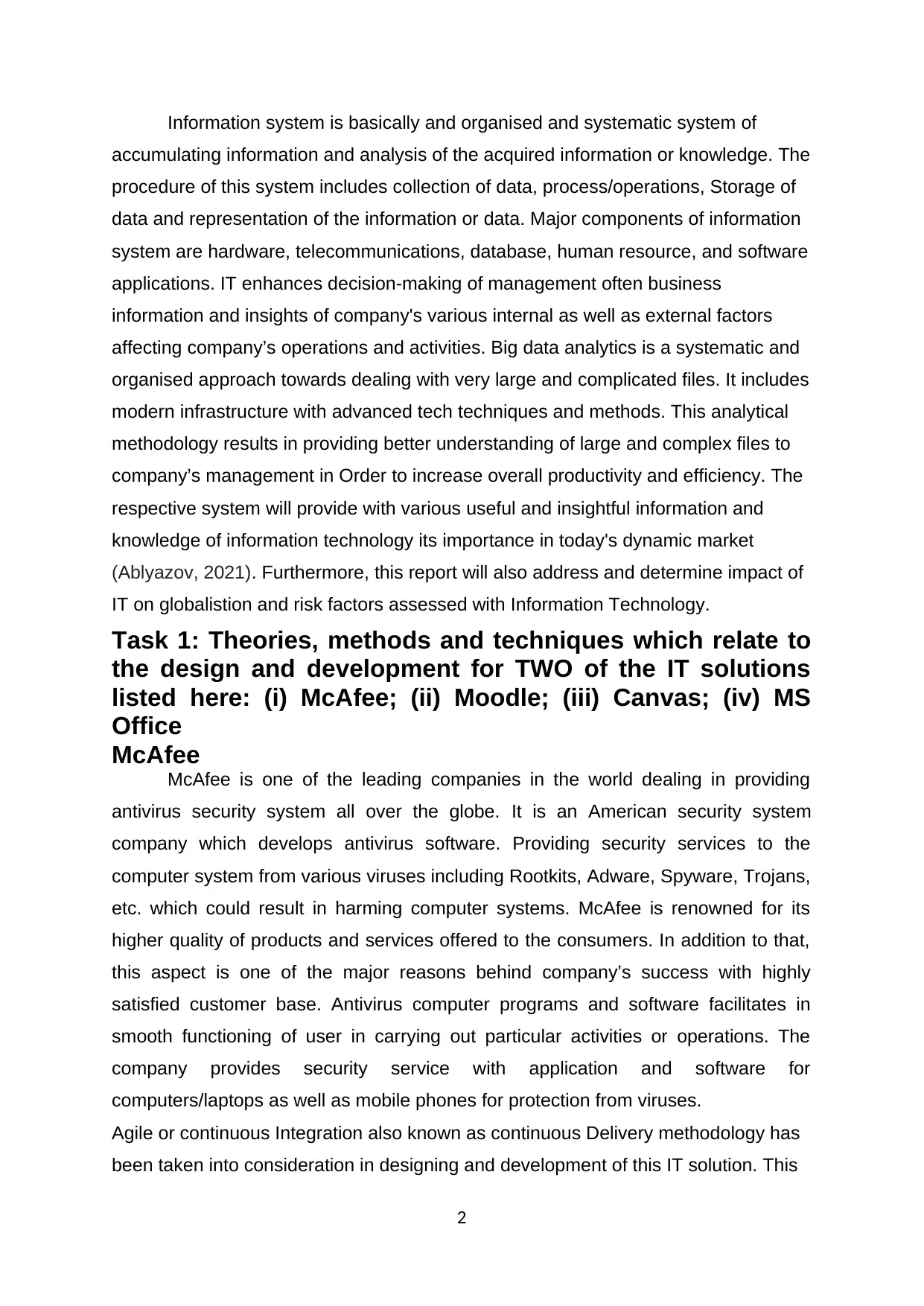
Information system is basically and organised and systematic system of
accumulating information and analysis of the acquired information or knowledge. The
procedure of this system includes collection of data, process/operations, Storage of
data and representation of the information or data. Major components of information
system are hardware, telecommunications, database, human resource, and software
applications. IT enhances decision-making of management often business
information and insights of company's various internal as well as external factors
affecting company’s operations and activities. Big data analytics is a systematic and
organised approach towards dealing with very large and complicated files. It includes
modern infrastructure with advanced tech techniques and methods. This analytical
methodology results in providing better understanding of large and complex files to
company’s management in Order to increase overall productivity and efficiency. The
respective system will provide with various useful and insightful information and
knowledge of information technology its importance in today's dynamic market
(Ablyazov, 2021). Furthermore, this report will also address and determine impact of
IT on globalistion and risk factors assessed with Information Technology.
Task 1: Theories, methods and techniques which relate to
the design and development for TWO of the IT solutions
listed here: (i) McAfee; (ii) Moodle; (iii) Canvas; (iv) MS
Office
McAfee
McAfee is one of the leading companies in the world dealing in providing
antivirus security system all over the globe. It is an American security system
company which develops antivirus software. Providing security services to the
computer system from various viruses including Rootkits, Adware, Spyware, Trojans,
etc. which could result in harming computer systems. McAfee is renowned for its
higher quality of products and services offered to the consumers. In addition to that,
this aspect is one of the major reasons behind company’s success with highly
satisfied customer base. Antivirus computer programs and software facilitates in
smooth functioning of user in carrying out particular activities or operations. The
company provides security service with application and software for
computers/laptops as well as mobile phones for protection from viruses.
Agile or continuous Integration also known as continuous Delivery methodology has
been taken into consideration in designing and development of this IT solution. This
2
accumulating information and analysis of the acquired information or knowledge. The
procedure of this system includes collection of data, process/operations, Storage of
data and representation of the information or data. Major components of information
system are hardware, telecommunications, database, human resource, and software
applications. IT enhances decision-making of management often business
information and insights of company's various internal as well as external factors
affecting company’s operations and activities. Big data analytics is a systematic and
organised approach towards dealing with very large and complicated files. It includes
modern infrastructure with advanced tech techniques and methods. This analytical
methodology results in providing better understanding of large and complex files to
company’s management in Order to increase overall productivity and efficiency. The
respective system will provide with various useful and insightful information and
knowledge of information technology its importance in today's dynamic market
(Ablyazov, 2021). Furthermore, this report will also address and determine impact of
IT on globalistion and risk factors assessed with Information Technology.
Task 1: Theories, methods and techniques which relate to
the design and development for TWO of the IT solutions
listed here: (i) McAfee; (ii) Moodle; (iii) Canvas; (iv) MS
Office
McAfee
McAfee is one of the leading companies in the world dealing in providing
antivirus security system all over the globe. It is an American security system
company which develops antivirus software. Providing security services to the
computer system from various viruses including Rootkits, Adware, Spyware, Trojans,
etc. which could result in harming computer systems. McAfee is renowned for its
higher quality of products and services offered to the consumers. In addition to that,
this aspect is one of the major reasons behind company’s success with highly
satisfied customer base. Antivirus computer programs and software facilitates in
smooth functioning of user in carrying out particular activities or operations. The
company provides security service with application and software for
computers/laptops as well as mobile phones for protection from viruses.
Agile or continuous Integration also known as continuous Delivery methodology has
been taken into consideration in designing and development of this IT solution. This
2
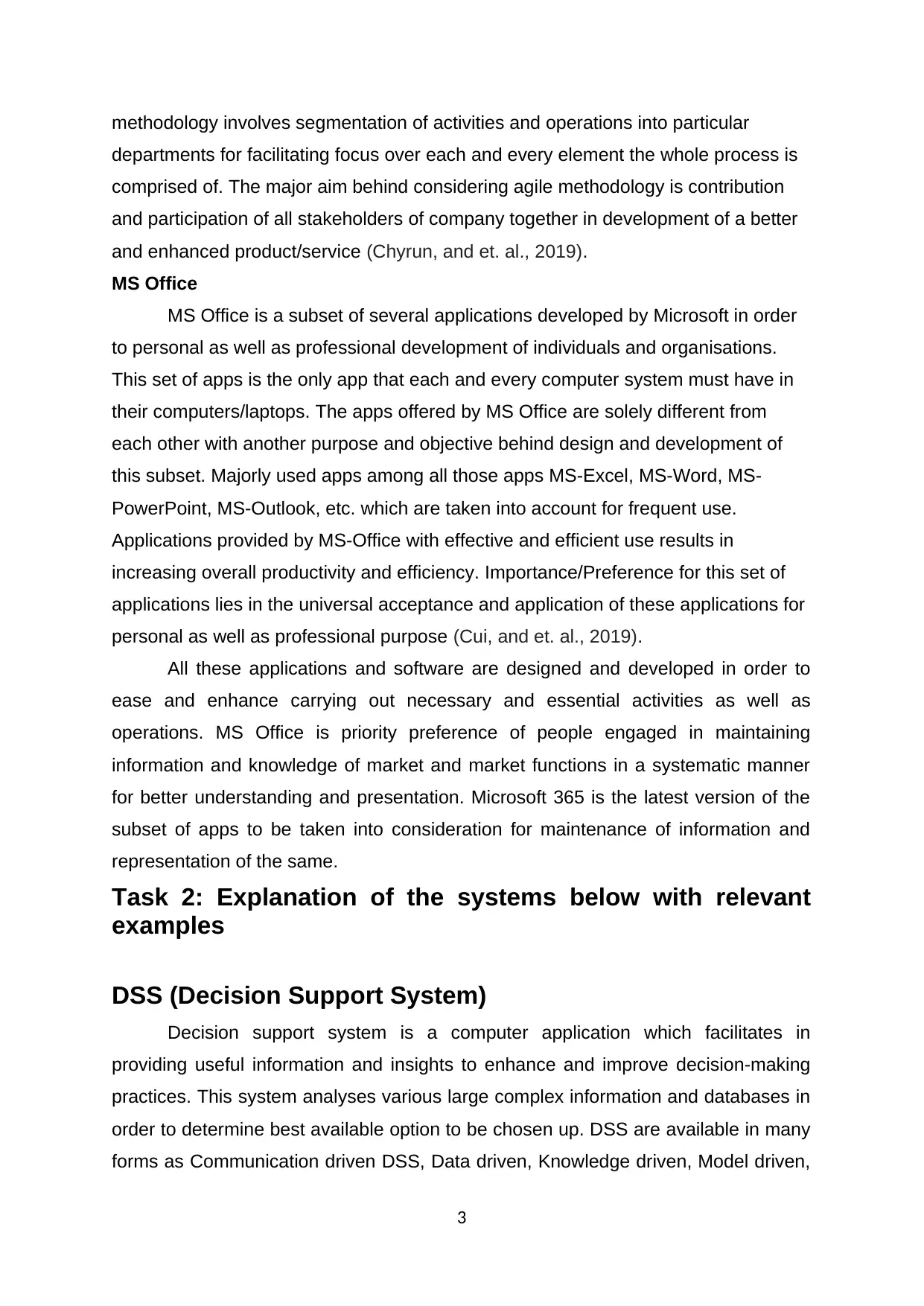
methodology involves segmentation of activities and operations into particular
departments for facilitating focus over each and every element the whole process is
comprised of. The major aim behind considering agile methodology is contribution
and participation of all stakeholders of company together in development of a better
and enhanced product/service (Chyrun, and et. al., 2019).
MS Office
MS Office is a subset of several applications developed by Microsoft in order
to personal as well as professional development of individuals and organisations.
This set of apps is the only app that each and every computer system must have in
their computers/laptops. The apps offered by MS Office are solely different from
each other with another purpose and objective behind design and development of
this subset. Majorly used apps among all those apps MS-Excel, MS-Word, MS-
PowerPoint, MS-Outlook, etc. which are taken into account for frequent use.
Applications provided by MS-Office with effective and efficient use results in
increasing overall productivity and efficiency. Importance/Preference for this set of
applications lies in the universal acceptance and application of these applications for
personal as well as professional purpose (Cui, and et. al., 2019).
All these applications and software are designed and developed in order to
ease and enhance carrying out necessary and essential activities as well as
operations. MS Office is priority preference of people engaged in maintaining
information and knowledge of market and market functions in a systematic manner
for better understanding and presentation. Microsoft 365 is the latest version of the
subset of apps to be taken into consideration for maintenance of information and
representation of the same.
Task 2: Explanation of the systems below with relevant
examples
DSS (Decision Support System)
Decision support system is a computer application which facilitates in
providing useful information and insights to enhance and improve decision-making
practices. This system analyses various large complex information and databases in
order to determine best available option to be chosen up. DSS are available in many
forms as Communication driven DSS, Data driven, Knowledge driven, Model driven,
3
departments for facilitating focus over each and every element the whole process is
comprised of. The major aim behind considering agile methodology is contribution
and participation of all stakeholders of company together in development of a better
and enhanced product/service (Chyrun, and et. al., 2019).
MS Office
MS Office is a subset of several applications developed by Microsoft in order
to personal as well as professional development of individuals and organisations.
This set of apps is the only app that each and every computer system must have in
their computers/laptops. The apps offered by MS Office are solely different from
each other with another purpose and objective behind design and development of
this subset. Majorly used apps among all those apps MS-Excel, MS-Word, MS-
PowerPoint, MS-Outlook, etc. which are taken into account for frequent use.
Applications provided by MS-Office with effective and efficient use results in
increasing overall productivity and efficiency. Importance/Preference for this set of
applications lies in the universal acceptance and application of these applications for
personal as well as professional purpose (Cui, and et. al., 2019).
All these applications and software are designed and developed in order to
ease and enhance carrying out necessary and essential activities as well as
operations. MS Office is priority preference of people engaged in maintaining
information and knowledge of market and market functions in a systematic manner
for better understanding and presentation. Microsoft 365 is the latest version of the
subset of apps to be taken into consideration for maintenance of information and
representation of the same.
Task 2: Explanation of the systems below with relevant
examples
DSS (Decision Support System)
Decision support system is a computer application which facilitates in
providing useful information and insights to enhance and improve decision-making
practices. This system analyses various large complex information and databases in
order to determine best available option to be chosen up. DSS are available in many
forms as Communication driven DSS, Data driven, Knowledge driven, Model driven,
3
Secure Best Marks with AI Grader
Need help grading? Try our AI Grader for instant feedback on your assignments.
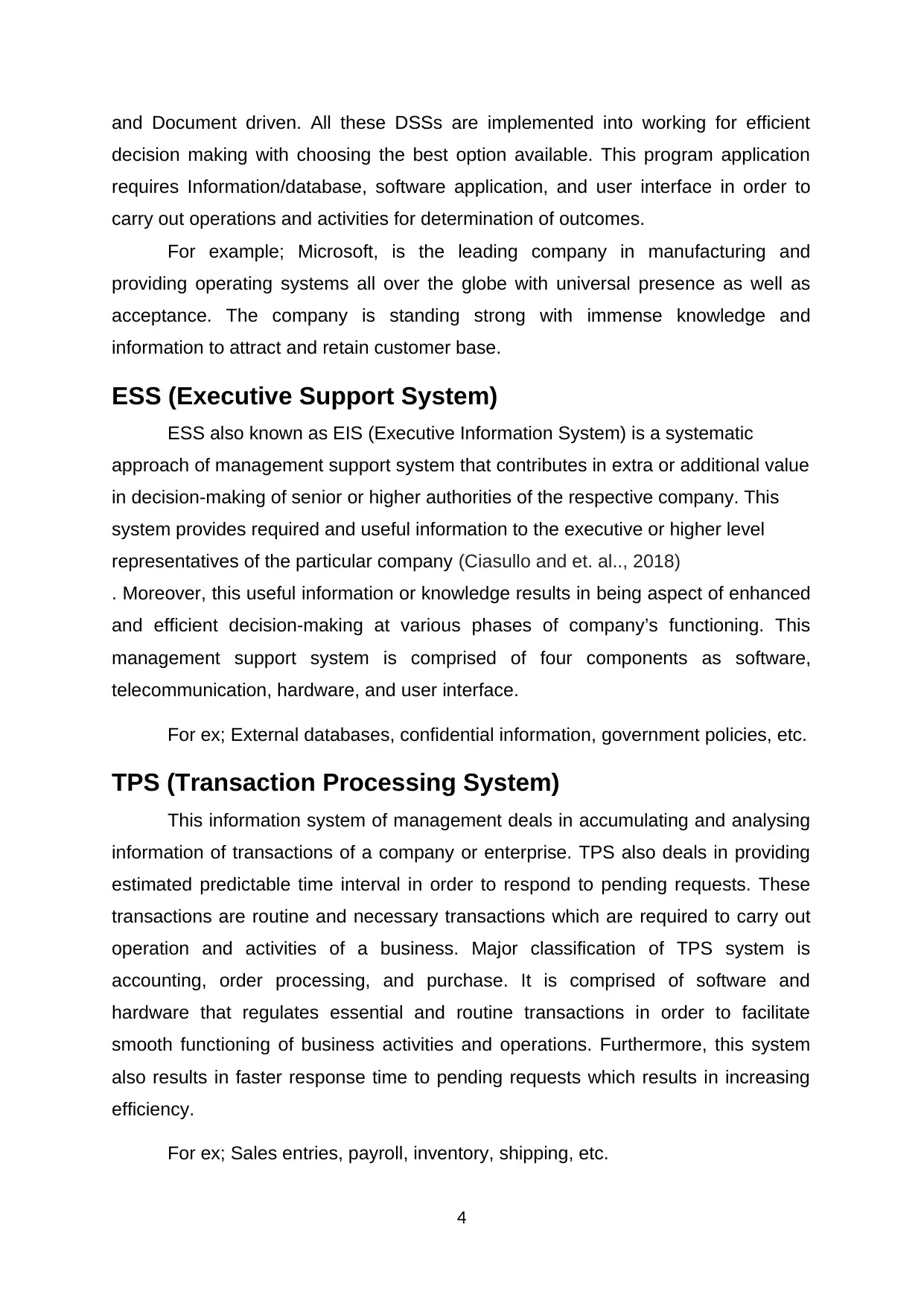
and Document driven. All these DSSs are implemented into working for efficient
decision making with choosing the best option available. This program application
requires Information/database, software application, and user interface in order to
carry out operations and activities for determination of outcomes.
For example; Microsoft, is the leading company in manufacturing and
providing operating systems all over the globe with universal presence as well as
acceptance. The company is standing strong with immense knowledge and
information to attract and retain customer base.
ESS (Executive Support System)
ESS also known as EIS (Executive Information System) is a systematic
approach of management support system that contributes in extra or additional value
in decision-making of senior or higher authorities of the respective company. This
system provides required and useful information to the executive or higher level
representatives of the particular company (Ciasullo and et. al.., 2018)
. Moreover, this useful information or knowledge results in being aspect of enhanced
and efficient decision-making at various phases of company’s functioning. This
management support system is comprised of four components as software,
telecommunication, hardware, and user interface.
For ex; External databases, confidential information, government policies, etc.
TPS (Transaction Processing System)
This information system of management deals in accumulating and analysing
information of transactions of a company or enterprise. TPS also deals in providing
estimated predictable time interval in order to respond to pending requests. These
transactions are routine and necessary transactions which are required to carry out
operation and activities of a business. Major classification of TPS system is
accounting, order processing, and purchase. It is comprised of software and
hardware that regulates essential and routine transactions in order to facilitate
smooth functioning of business activities and operations. Furthermore, this system
also results in faster response time to pending requests which results in increasing
efficiency.
For ex; Sales entries, payroll, inventory, shipping, etc.
4
decision making with choosing the best option available. This program application
requires Information/database, software application, and user interface in order to
carry out operations and activities for determination of outcomes.
For example; Microsoft, is the leading company in manufacturing and
providing operating systems all over the globe with universal presence as well as
acceptance. The company is standing strong with immense knowledge and
information to attract and retain customer base.
ESS (Executive Support System)
ESS also known as EIS (Executive Information System) is a systematic
approach of management support system that contributes in extra or additional value
in decision-making of senior or higher authorities of the respective company. This
system provides required and useful information to the executive or higher level
representatives of the particular company (Ciasullo and et. al.., 2018)
. Moreover, this useful information or knowledge results in being aspect of enhanced
and efficient decision-making at various phases of company’s functioning. This
management support system is comprised of four components as software,
telecommunication, hardware, and user interface.
For ex; External databases, confidential information, government policies, etc.
TPS (Transaction Processing System)
This information system of management deals in accumulating and analysing
information of transactions of a company or enterprise. TPS also deals in providing
estimated predictable time interval in order to respond to pending requests. These
transactions are routine and necessary transactions which are required to carry out
operation and activities of a business. Major classification of TPS system is
accounting, order processing, and purchase. It is comprised of software and
hardware that regulates essential and routine transactions in order to facilitate
smooth functioning of business activities and operations. Furthermore, this system
also results in faster response time to pending requests which results in increasing
efficiency.
For ex; Sales entries, payroll, inventory, shipping, etc.
4

MIS (Management Information System)
This information system of management deals with information of each and
every component/element of business or business operations. It is basically
determined as knowledge of workforce, company, technological aspects, etc. and
their connectivity with each other for effective and efficient results. This report
regulates a systematic process which includes acquiring data from various available
sources, analysis of acquired information, and interpretation of results in order to
enhance strategic planning and decision-making. The major purpose of MIS is to
regulate and maintain smooth flow of information throughout different departments
for effective functioning (Fedorova, 2021)
. Therefore, it results development and improvement of interconnectivity among
different departments making up the working environment.
For ex; order processing, human resource, sales and marketing, etc.
KMS (Knowledge Management System)
Knowledge management system is another IT system applied in management
which deals in stores and rectifies information in order to promote better
understanding of the same. This system is majorly oriented with the purpose of
acquiring useful insights that allows you to know more about target customer base.
For instance, KSM is further classified into three which are intelligent techniques,
enterprise-wide knowledge, and knowledge work systems. Therefore, it results in
completion of desired goals and objectives.
For ex; research and insights libraries, organisation, customer service
feedbacks, etc.
Task 3: Globalisation and the effects of IT on globalisation
Globalisation is basically meant by the rising interconnectivity and
interdependence among nations and economies all around the globe. For instance,
reason behind this interdependence being cross-border trades of products and
services on a worldwide platform to be carried out. This cross-border trade between
countries and economic markets includes products and services, technological
innovations, monetary flow, information, etc. in order to look after economic growth
and development (Gribanov, Rudenko and Alenina, 2020). The major purpose of
5
This information system of management deals with information of each and
every component/element of business or business operations. It is basically
determined as knowledge of workforce, company, technological aspects, etc. and
their connectivity with each other for effective and efficient results. This report
regulates a systematic process which includes acquiring data from various available
sources, analysis of acquired information, and interpretation of results in order to
enhance strategic planning and decision-making. The major purpose of MIS is to
regulate and maintain smooth flow of information throughout different departments
for effective functioning (Fedorova, 2021)
. Therefore, it results development and improvement of interconnectivity among
different departments making up the working environment.
For ex; order processing, human resource, sales and marketing, etc.
KMS (Knowledge Management System)
Knowledge management system is another IT system applied in management
which deals in stores and rectifies information in order to promote better
understanding of the same. This system is majorly oriented with the purpose of
acquiring useful insights that allows you to know more about target customer base.
For instance, KSM is further classified into three which are intelligent techniques,
enterprise-wide knowledge, and knowledge work systems. Therefore, it results in
completion of desired goals and objectives.
For ex; research and insights libraries, organisation, customer service
feedbacks, etc.
Task 3: Globalisation and the effects of IT on globalisation
Globalisation is basically meant by the rising interconnectivity and
interdependence among nations and economies all around the globe. For instance,
reason behind this interdependence being cross-border trades of products and
services on a worldwide platform to be carried out. This cross-border trade between
countries and economic markets includes products and services, technological
innovations, monetary flow, information, etc. in order to look after economic growth
and development (Gribanov, Rudenko and Alenina, 2020). The major purpose of
5
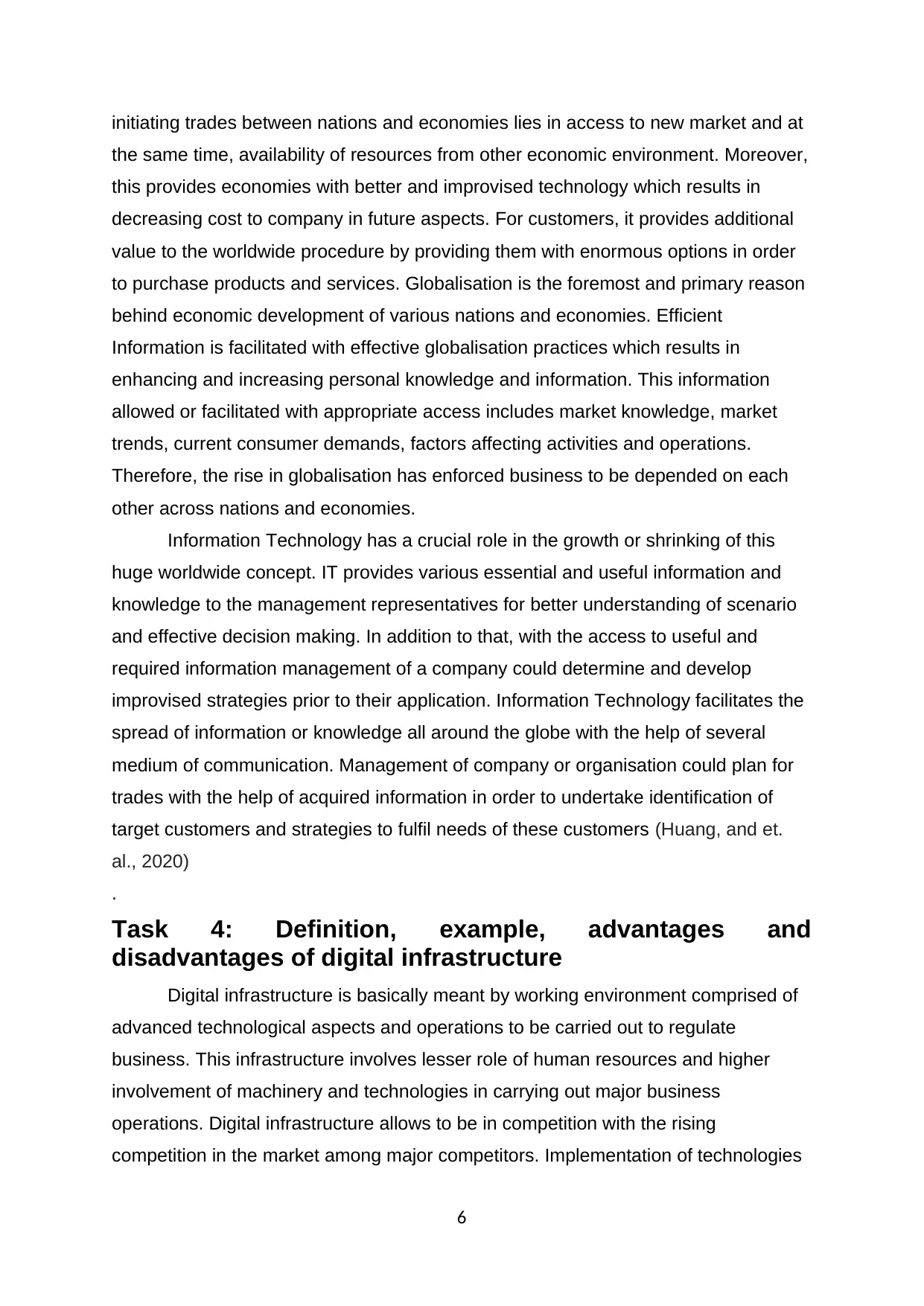
initiating trades between nations and economies lies in access to new market and at
the same time, availability of resources from other economic environment. Moreover,
this provides economies with better and improvised technology which results in
decreasing cost to company in future aspects. For customers, it provides additional
value to the worldwide procedure by providing them with enormous options in order
to purchase products and services. Globalisation is the foremost and primary reason
behind economic development of various nations and economies. Efficient
Information is facilitated with effective globalisation practices which results in
enhancing and increasing personal knowledge and information. This information
allowed or facilitated with appropriate access includes market knowledge, market
trends, current consumer demands, factors affecting activities and operations.
Therefore, the rise in globalisation has enforced business to be depended on each
other across nations and economies.
Information Technology has a crucial role in the growth or shrinking of this
huge worldwide concept. IT provides various essential and useful information and
knowledge to the management representatives for better understanding of scenario
and effective decision making. In addition to that, with the access to useful and
required information management of a company could determine and develop
improvised strategies prior to their application. Information Technology facilitates the
spread of information or knowledge all around the globe with the help of several
medium of communication. Management of company or organisation could plan for
trades with the help of acquired information in order to undertake identification of
target customers and strategies to fulfil needs of these customers (Huang, and et.
al., 2020)
.
Task 4: Definition, example, advantages and
disadvantages of digital infrastructure
Digital infrastructure is basically meant by working environment comprised of
advanced technological aspects and operations to be carried out to regulate
business. This infrastructure involves lesser role of human resources and higher
involvement of machinery and technologies in carrying out major business
operations. Digital infrastructure allows to be in competition with the rising
competition in the market among major competitors. Implementation of technologies
6
the same time, availability of resources from other economic environment. Moreover,
this provides economies with better and improvised technology which results in
decreasing cost to company in future aspects. For customers, it provides additional
value to the worldwide procedure by providing them with enormous options in order
to purchase products and services. Globalisation is the foremost and primary reason
behind economic development of various nations and economies. Efficient
Information is facilitated with effective globalisation practices which results in
enhancing and increasing personal knowledge and information. This information
allowed or facilitated with appropriate access includes market knowledge, market
trends, current consumer demands, factors affecting activities and operations.
Therefore, the rise in globalisation has enforced business to be depended on each
other across nations and economies.
Information Technology has a crucial role in the growth or shrinking of this
huge worldwide concept. IT provides various essential and useful information and
knowledge to the management representatives for better understanding of scenario
and effective decision making. In addition to that, with the access to useful and
required information management of a company could determine and develop
improvised strategies prior to their application. Information Technology facilitates the
spread of information or knowledge all around the globe with the help of several
medium of communication. Management of company or organisation could plan for
trades with the help of acquired information in order to undertake identification of
target customers and strategies to fulfil needs of these customers (Huang, and et.
al., 2020)
.
Task 4: Definition, example, advantages and
disadvantages of digital infrastructure
Digital infrastructure is basically meant by working environment comprised of
advanced technological aspects and operations to be carried out to regulate
business. This infrastructure involves lesser role of human resources and higher
involvement of machinery and technologies in carrying out major business
operations. Digital infrastructure allows to be in competition with the rising
competition in the market among major competitors. Implementation of technologies
6
Paraphrase This Document
Need a fresh take? Get an instant paraphrase of this document with our AI Paraphraser
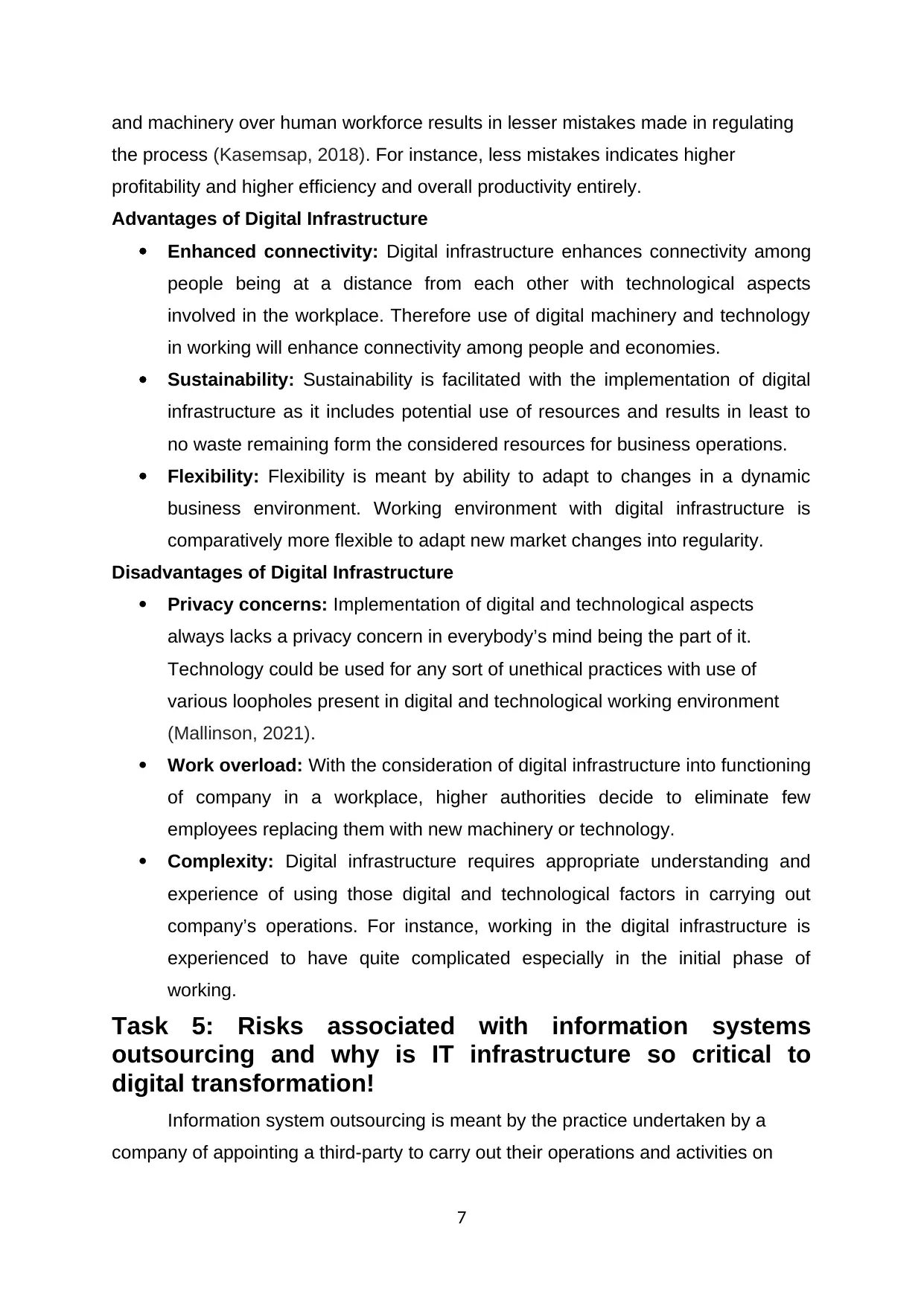
and machinery over human workforce results in lesser mistakes made in regulating
the process (Kasemsap, 2018). For instance, less mistakes indicates higher
profitability and higher efficiency and overall productivity entirely.
Advantages of Digital Infrastructure
Enhanced connectivity: Digital infrastructure enhances connectivity among
people being at a distance from each other with technological aspects
involved in the workplace. Therefore use of digital machinery and technology
in working will enhance connectivity among people and economies.
Sustainability: Sustainability is facilitated with the implementation of digital
infrastructure as it includes potential use of resources and results in least to
no waste remaining form the considered resources for business operations.
Flexibility: Flexibility is meant by ability to adapt to changes in a dynamic
business environment. Working environment with digital infrastructure is
comparatively more flexible to adapt new market changes into regularity.
Disadvantages of Digital Infrastructure
Privacy concerns: Implementation of digital and technological aspects
always lacks a privacy concern in everybody’s mind being the part of it.
Technology could be used for any sort of unethical practices with use of
various loopholes present in digital and technological working environment
(Mallinson, 2021).
Work overload: With the consideration of digital infrastructure into functioning
of company in a workplace, higher authorities decide to eliminate few
employees replacing them with new machinery or technology.
Complexity: Digital infrastructure requires appropriate understanding and
experience of using those digital and technological factors in carrying out
company’s operations. For instance, working in the digital infrastructure is
experienced to have quite complicated especially in the initial phase of
working.
Task 5: Risks associated with information systems
outsourcing and why is IT infrastructure so critical to
digital transformation!
Information system outsourcing is meant by the practice undertaken by a
company of appointing a third-party to carry out their operations and activities on
7
the process (Kasemsap, 2018). For instance, less mistakes indicates higher
profitability and higher efficiency and overall productivity entirely.
Advantages of Digital Infrastructure
Enhanced connectivity: Digital infrastructure enhances connectivity among
people being at a distance from each other with technological aspects
involved in the workplace. Therefore use of digital machinery and technology
in working will enhance connectivity among people and economies.
Sustainability: Sustainability is facilitated with the implementation of digital
infrastructure as it includes potential use of resources and results in least to
no waste remaining form the considered resources for business operations.
Flexibility: Flexibility is meant by ability to adapt to changes in a dynamic
business environment. Working environment with digital infrastructure is
comparatively more flexible to adapt new market changes into regularity.
Disadvantages of Digital Infrastructure
Privacy concerns: Implementation of digital and technological aspects
always lacks a privacy concern in everybody’s mind being the part of it.
Technology could be used for any sort of unethical practices with use of
various loopholes present in digital and technological working environment
(Mallinson, 2021).
Work overload: With the consideration of digital infrastructure into functioning
of company in a workplace, higher authorities decide to eliminate few
employees replacing them with new machinery or technology.
Complexity: Digital infrastructure requires appropriate understanding and
experience of using those digital and technological factors in carrying out
company’s operations. For instance, working in the digital infrastructure is
experienced to have quite complicated especially in the initial phase of
working.
Task 5: Risks associated with information systems
outsourcing and why is IT infrastructure so critical to
digital transformation!
Information system outsourcing is meant by the practice undertaken by a
company of appointing a third-party to carry out their operations and activities on
7

company’s behalf (Monteiro, and et. al., 2018). For instance, these third-parties are
often hired as a technical support to company as they regulate their activities and
operations.
Risks associated with information systems outsourcing
Unskilled workforce: The appointed third-party for carrying out company’s
operations could provide us with a pitfall of indulging unskilled workforce in
order to implement their functioning. Completion of work through these
unskilled workers could result in low quality of final outcomes or results.
Loss of control: Once the company has allowed authority of handling the
activities and operations to the third party it will make company lose the
control over the process of completion of work or tasks. This aspect could
become risk to information system outsourcing to any third-party regulating
business activities and operations on company’s behalf (Wang, and et. al.,
2021).
Unseen costs: These third-parties charge an amount of fees for carrying out
company’s operations on their behalf. The problem arises when their fees and
charges somehow includes invisible or unseen costs which was not
mentioned prior to execution of procedure. These hidden costs and unseen
costs could result in being a major risk to company and company’s
operations.
Privacy concerns: Every company or organisation has confidential data and
information that cannot be disclosed to general public or competitors in the
market. Delegation of tasks and activities to third creates a risk of privacy of
data or information to be leaked out in the market.
Therefore, these aspects could be a risk to information system outsourcing to
third parties.
Why is IT infrastructure so critical to digital transformation!
Infrastructure is critical to digital transformation as digital infrastructure
facilitates in innovation and social and economic growth. Advanced and digital
technology is a universal need which could enhance any sort of business opportunity
with efficiency and increasing productivity (Zajda and Majhanovich, 2018)
. Digital infrastructure provides various values to digital transformation which are as
follows:
Faster responses to need for change
8
often hired as a technical support to company as they regulate their activities and
operations.
Risks associated with information systems outsourcing
Unskilled workforce: The appointed third-party for carrying out company’s
operations could provide us with a pitfall of indulging unskilled workforce in
order to implement their functioning. Completion of work through these
unskilled workers could result in low quality of final outcomes or results.
Loss of control: Once the company has allowed authority of handling the
activities and operations to the third party it will make company lose the
control over the process of completion of work or tasks. This aspect could
become risk to information system outsourcing to any third-party regulating
business activities and operations on company’s behalf (Wang, and et. al.,
2021).
Unseen costs: These third-parties charge an amount of fees for carrying out
company’s operations on their behalf. The problem arises when their fees and
charges somehow includes invisible or unseen costs which was not
mentioned prior to execution of procedure. These hidden costs and unseen
costs could result in being a major risk to company and company’s
operations.
Privacy concerns: Every company or organisation has confidential data and
information that cannot be disclosed to general public or competitors in the
market. Delegation of tasks and activities to third creates a risk of privacy of
data or information to be leaked out in the market.
Therefore, these aspects could be a risk to information system outsourcing to
third parties.
Why is IT infrastructure so critical to digital transformation!
Infrastructure is critical to digital transformation as digital infrastructure
facilitates in innovation and social and economic growth. Advanced and digital
technology is a universal need which could enhance any sort of business opportunity
with efficiency and increasing productivity (Zajda and Majhanovich, 2018)
. Digital infrastructure provides various values to digital transformation which are as
follows:
Faster responses to need for change
8
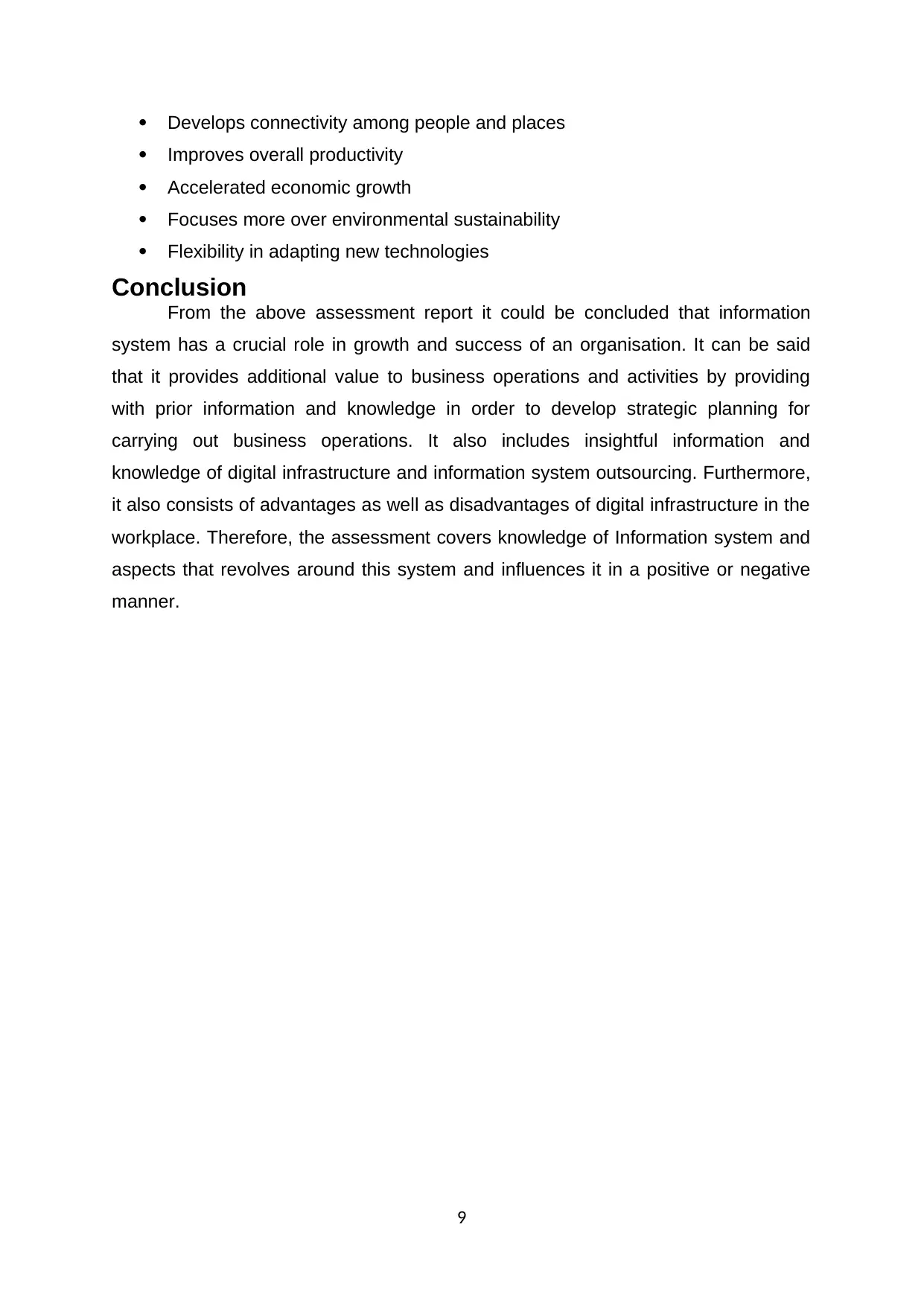
Develops connectivity among people and places
Improves overall productivity
Accelerated economic growth
Focuses more over environmental sustainability
Flexibility in adapting new technologies
Conclusion
From the above assessment report it could be concluded that information
system has a crucial role in growth and success of an organisation. It can be said
that it provides additional value to business operations and activities by providing
with prior information and knowledge in order to develop strategic planning for
carrying out business operations. It also includes insightful information and
knowledge of digital infrastructure and information system outsourcing. Furthermore,
it also consists of advantages as well as disadvantages of digital infrastructure in the
workplace. Therefore, the assessment covers knowledge of Information system and
aspects that revolves around this system and influences it in a positive or negative
manner.
9
Improves overall productivity
Accelerated economic growth
Focuses more over environmental sustainability
Flexibility in adapting new technologies
Conclusion
From the above assessment report it could be concluded that information
system has a crucial role in growth and success of an organisation. It can be said
that it provides additional value to business operations and activities by providing
with prior information and knowledge in order to develop strategic planning for
carrying out business operations. It also includes insightful information and
knowledge of digital infrastructure and information system outsourcing. Furthermore,
it also consists of advantages as well as disadvantages of digital infrastructure in the
workplace. Therefore, the assessment covers knowledge of Information system and
aspects that revolves around this system and influences it in a positive or negative
manner.
9
Secure Best Marks with AI Grader
Need help grading? Try our AI Grader for instant feedback on your assignments.

References
Books and Journals
Ablyazov, T., 2021. Application of digital platforms in the urban infrastructure
development. In SHS Web of Conferences (Vol. 106). EDP Sciences.
Chyrun, and et. al., 2019, May. Information System for Connection to the Access
Point with Encryption WPA2 Enterprise. In International Scientific
Conference “Intellectual Systems of Decision Making and Problem of
Computational Intelligence” (pp. 389-404). Springer, Cham.
Ciasullo and et. al.., 2018. Business process outsourcing enhanced by fuzzy
linguistic consensus model. Applied Soft Computing, 64, pp.436-444.
Cui, and et. al., 2019. Understanding information system success model and valence
framework in sellers’ acceptance of cross-border e-commerce: a sequential
multi-method approach. Electronic Commerce Research, 19(4), pp.885-914.
Fedorova, S., 2021. IT outsourcing development trends. In SHS Web of
Conferences (Vol. 106). EDP Sciences.
Gribanov, Y. I., Rudenko, M. N. and Alenina, K. A., 2020. Modern Approaches to
Formation of Digital Infrastructure. Administrative Consulting.
Huang, and et. al., 2020. An inventive high-performance computing electronic
information system for professional postgraduate training. International
Journal of Computers and Applications, 42(4), pp.422-428.
Kasemsap, K., 2018. The role of information system within enterprise architecture
and their impact on business performance. In Global Business Expansion:
Concepts, Methodologies, Tools, and Applications (pp. 1078-1102). IGI
Global.
Mallinson, W., 2021. The Effects of Globalisation. In Guicciardini, Geopolitics and
Geohistory (pp. 99-118). Palgrave Macmillan, Cham.
Monteiro, and et. al., 2018. An urban building database (UBD) supporting a smart
city information system. Energy and Buildings, 158, pp.244-260.
Wang, and et. al., 2021. Secure computation protocols under asymmetric scenarios
in enterprise information system. Enterprise Information Systems, 15(4),
pp.492-512.
Zajda, J. and Majhanovich, S., Globalisation, Cultural Identity and Nation-Building.
10
Books and Journals
Ablyazov, T., 2021. Application of digital platforms in the urban infrastructure
development. In SHS Web of Conferences (Vol. 106). EDP Sciences.
Chyrun, and et. al., 2019, May. Information System for Connection to the Access
Point with Encryption WPA2 Enterprise. In International Scientific
Conference “Intellectual Systems of Decision Making and Problem of
Computational Intelligence” (pp. 389-404). Springer, Cham.
Ciasullo and et. al.., 2018. Business process outsourcing enhanced by fuzzy
linguistic consensus model. Applied Soft Computing, 64, pp.436-444.
Cui, and et. al., 2019. Understanding information system success model and valence
framework in sellers’ acceptance of cross-border e-commerce: a sequential
multi-method approach. Electronic Commerce Research, 19(4), pp.885-914.
Fedorova, S., 2021. IT outsourcing development trends. In SHS Web of
Conferences (Vol. 106). EDP Sciences.
Gribanov, Y. I., Rudenko, M. N. and Alenina, K. A., 2020. Modern Approaches to
Formation of Digital Infrastructure. Administrative Consulting.
Huang, and et. al., 2020. An inventive high-performance computing electronic
information system for professional postgraduate training. International
Journal of Computers and Applications, 42(4), pp.422-428.
Kasemsap, K., 2018. The role of information system within enterprise architecture
and their impact on business performance. In Global Business Expansion:
Concepts, Methodologies, Tools, and Applications (pp. 1078-1102). IGI
Global.
Mallinson, W., 2021. The Effects of Globalisation. In Guicciardini, Geopolitics and
Geohistory (pp. 99-118). Palgrave Macmillan, Cham.
Monteiro, and et. al., 2018. An urban building database (UBD) supporting a smart
city information system. Energy and Buildings, 158, pp.244-260.
Wang, and et. al., 2021. Secure computation protocols under asymmetric scenarios
in enterprise information system. Enterprise Information Systems, 15(4),
pp.492-512.
Zajda, J. and Majhanovich, S., Globalisation, Cultural Identity and Nation-Building.
10
1 out of 11
Your All-in-One AI-Powered Toolkit for Academic Success.
+13062052269
info@desklib.com
Available 24*7 on WhatsApp / Email
![[object Object]](/_next/static/media/star-bottom.7253800d.svg)
Unlock your academic potential
© 2024 | Zucol Services PVT LTD | All rights reserved.



